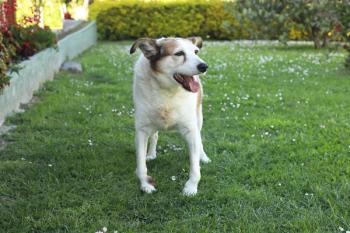
- August 2017
- Volume 2
- Issue 4
Repair Surgery Among Latest Treatments for Mitral Valve Disease
We highlight exciting new and upcoming advances in the treatment of the most common heart disease in dogs, plus a pet owner’s account of her dog’s reparative surgery.
Degenerative mitral valve disease (MVD) is the most common heart problem seen in dogs1 and typically affects small dogs aged 10 years and older. In most cases, the disease is managed medically, but Michele Borgarelli, DVM, PhD, DECVIM-CA, who lectured on the topic at the American College of Veterinary Internal Medicine (ACVIM) Forum in National Harbor, Maryland in June, says an upcoming ACVIM consensus statement on the treatment of MVD will include surgical repair as a possible option. (ACVIM was unable to confirm this because the statement has yet to be pub­lished in the Journal of Veterinary Internal Medicine.) “That’s a big change in the recommendation guidelines,” says Dr. Bor­garelli, an associate professor of cardiology at the Virginia—Maryland College of Veterinary Medicine.
Veterinary cardiology experts have sought a way to replace the mitral valve surgically for some 30 years, with no success. A dozen years ago, Masami Uechi, DVM, PhD, director of the JASMINE Veterinary Car­diovascular Medical Center in Kanagawa, Japan, developed an open-heart technique to repair the valve. He has performed approximately 700 of the procedures to date and claims a 90% success rate. The surgery is available only in Japan, Singa­pore, and France, but a small number of American dog own­ers are seeking it out despite the expense of the surgery and the cost of travel (BOX).
Simon Swift, VetMB, DECVIM-CA, clinical associate profes­sor of cardiology at the University of Florida, hopes to intro­duce the surgery to North America. He is heading up a 3-year plan to put together a surgical team to perform the procedure in the United States. Dr. Borgarelli is working on a technique in which a device is used to repair or replace the chordae tend­ineae, which hold the mitral valve in place but can stretch or rupture, worsening mitral re­gurgitation. The device would also be used to perform mitral annu­loplasty to reduce the dimension of the valve’s orifice, decreasing regurgitation.
Sabine Bozon, DVM, and her hus­band, Jean-Hugues Bozon, DVM, who co-own Clinique Veterinaire Bozon in Versailles, France, lead the surgical team that per­forms the mitral valve repair in France, in partnership with Dr. Uechi. While the Bozons and Dr. Uechi would like the pro­cedure to be more widely available, Dr. Bozon warns that the technique is not easy to master, noting that other veterinary surgeons have tried to replicate it but have met with limited success. She credits Dr. Uechi’s success rate to years of prac­tice and a surgical team that can recognize and react quickly to many complications.
Even if mitral valve repair surgery becomes available in the United States, Timothy Hodge, DVM, DACVIM (Cardiology), a cardiologist at the University of California Veterinary Medi­cal Center in San Diego, does not foresee it becoming a main­stream procedure. “The procedure requires the most advanced equipment and a large, specially trained team,” he says.
The best candidates for mitral valve repair surgery are young to middle-aged dogs in otherwise good health. Dogs with certain health conditions, such as Cushing’s disease or protein-losing enteropathy, are at greater risk for complications, as are dogs older than age 12 or 13. When surgery is successful, patients have an excellent prognosis. “Once dogs have their valve re­paired, they don’t die of this disease. Generally speaking, they die of something else,” Dr. Swift says.
Despite the significant improvements it has made in dogs with degenerative MVD, there are drawbacks to the surgery that prevent its widespread implementation. These include its limited availability, high cost, and certain inherent risks with cardiopulmonary bypass, says Sarah Miller, DVM, DACVIM (Cardiology), who practices at Southern California Veterinary Specialty Hospital in Irvine.
MEDICAL MANAGEMENT
Not every owner can afford to have a dog’s mitral valve repaired surgically, and not every dog needs it. Medical management alone can add years to a dog’s life. “Some dogs are very good on medical treatment until death,” Dr. Bozon says. “It depends on the gene involved and how fast the disease is progressing.”
The medications used have not changed substantially over the past 10 years, but there are updates in when they are used. One example is pimobendan, which has been shown to delay death in dogs with degenerative MVD once they are in heart failure, Dr. Swift says, adding that the results of a study published in 2016 in the Journal of Veterinary Internal Medicine suggest that starting the drug in the preclinical stages once there is heart enlargement will delay the onset of heart failure itself.2
Even with medical treatment, dogs generally live only 9 to 12 months after the onset of heart failure, so delaying it can add time to a dog’s life. “If we can delay heart failure by signif­icant periods of time, that’s definitely worth doing,” Dr. Swift says. “Some people do have concerns about whether pimoben­dan is harmful at that point, but I have yet to see any data to support that.”
For general practitioners, the important thing to know about pimobendan is when to prescribe it. It should not be given be­fore the heart becomes enlarged. “Patients qualifying for early pimobendan use based on the EPIC study generally speaking must have at least a [grade] 3/6 left apical systolic murmur and moderate left heart enlargement diagnosed via thoracic ra­diographs and on echocardiogram,” Dr. Miller says. “The study clearly demonstrated a delay in the onset of congestive heart failure2; however, it is too soon to say if this benefit has been reproduced clinically.”
Diuretics are prescribed for any dog with signs of fluid in the lungs or abdomen. The standard diuretic is furosemide, which rids the body of excess fluid. However, the disease can reach a stage at which furosemide is no longer effective, even in large doses. In those cases, Dr. Swift says, there are two options. “You can add in a thiazide diuretic, which often helps because it blocks different bits of the kidney, or you can switch the dog from furosemide to a diuretic called torsemide, which is more potent,” she says. “We’ve had a lot of success with dogs being fairly end stage not responding to oral furosemide and we switch them to torsemide and they’ve done very well.”
It used to be thought that angiotensin-converting enzyme inhibitors, such as enalapril and benazepril, might delay the onset of congestive heart failure in dogs that were asymptomat­ic, but there is no evidence to support that, says Dr. Swift.
The fourth drug that can benefit dogs with degenerative MVD is spironolactone, a mild diuretic that is more properly thought of as an anti-aldosterone agent. Aldosterone is a hormone that gets upregulated in heart failure. Because it is toxic to myo­cardial cells, causing fibrosis and cell death, it can accelerate disease progression, Dr. Swift says.
One of the challenges of MVD is getting a correct diagnosis. Not every veterinarian or client has access to a board-certified cardiologist. “Echocardiography is the best noninvasive way to diagnose heart disease in dogs,” Dr. Hodge says. “Cardiologists receive advanced training specifically to perform and interpret echocardiography.”
The same issue makes treating the disease a challenge. Dr. Hodge says a study published in 2016 found that dogs cared for by a primary care veterinarian and a board-certified cardiologist working to­gether had longer survival times than dogs that did not have a cardiologist in­volved in their treatment.3
Another problem is the common but mistaken assumption that a dog with a murmur that coughs must be in heart failure. “That is absolutely not true,” Dr. Swift says. “The main reason dogs cough is because
either they have primary air­way disease or they have a big heart that’s compressing their airways. So, they will cough way before they have heart failure. Starting those patients on heart failure medication may be inappropriate. We see a lot of dogs that are put on high doses of diuretics for coughing, and actually they’re not cough­ing because they’ve got heart failure. Of course, they don’t get better, and what happens is the dose gets escalated. They can reach really high doses of diuret­ics before they get referred in [to a cardiologist].”
Even when they are neces­sary, high doses of diuretics can be frustrating for owners. Their dogs start having housetraining accidents or leaking urine in their sleep. “The most common mistake I see is when dogs are being managed successfully for congestive heart failure and either the owner or the referring veterinarian attempts to taper or stop the diuretic therapy,” Dr. Miller says. “These dogs often present in respiratory dis­tress on an emergency basis due to recurrent congestive heart failure, requiring more aggressive therapy for their disease and additional hospitalization cost and stress for the patient and owner.”
RESEARCH UNDER WAY
Researchers are exploring several possible treatments for degenerative MVD as well as continuing to seek the cause. At Cornell University, Vicky Yang, DVM, PhD, DACVIM (Car­diology), is evaluating the data from a small pilot study of the effects of stem cells and hopes to have results later this year. “We thought if mesenchymal stem cells are antifibrotic and anti-inflammatory, they could have a beneficial effect in con­trolling fibrosis in these heart valves,” she says.
A genetic therapy for Cavalier King Charles spaniels with the disease is the subject of a partnership between Harvard Medical School and Tufts University. However, the researchers preferred not to discuss their work until the trial is complete later this year.
Some veterinary surgeons, such as Christopher Orton, DVM, PhD, DACVS, at Colorado State University, are seeking a non­invasive method of valve replacement or repair, but the small size of many of the dogs that develop degenerative MVD— Cavalier King Charles spaniels, Chihuahuas, toy and miniature poodles, and Dachshunds are among the breeds in which it’s commonly seen—limits what can be done noninvasively to treat the disease.
“Catheter-based interventions will likely be the future treat­ment of choice, but the equipment is too large to be used currently in our small patients,” says Dr. Miller.
Dr. Borgarelli presented preliminary results from an ongoing longitudinal study of the natural history of MVD. Goals of the study include identifying and assessing the effects of comor­bidities that affect dogs with degenerative MVD, such as renal failure and chronic respiratory problems, as well as risk factors for disease progression and death. Currently, more than 2000 dogs are enrolled. Data will be collected until the study ends in October 2021.
Dr. Borgarelli is also studying valve morphology in Cavaliers. The Cavalier mitral valve has smaller, flatter leaflets than those of other dogs. “It looks like maybe the valves of these dogs have some disadvantages compared with valves from other breeds,” he says. “That may play a role in the development of disease. We are planning to do a longitudinal study that will look at the morphology of the valve and its relationship to age at onset of disease. I think that’s something that in the future could be important for screening.”
But a cure or treatment that is affordable and can extend life for many years is probably still far in the future. “Current research aims to evaluate why cardiac diseases are so prevalent in certain types of dogs or certain breeds,” says Dr. Hodge. “The answers may lie in genetic mutations, which may develop into targets for gene therapy. But as of right now, I do not know of any­one currently having success with these possible treatments.”
BOX.
Harper’s Story: My Dog’s Experience With Surgical Mitral Valve Repair
In May of this year, my husband and I took our 9-year-old Cava­lier King Charles spaniel, Harper, to France for mitral valve repair surgery. It’s not something we ever expected to do, but after seeing another of our dogs die from congestive heart failure 11 years ago, it was important to us not to go through that again. We wanted to give Harper the second chance that hadn’t been available to Darcy.
When Harper was diagnosed with congestive heart failure in January 2017, after several years of being asymptomatic, I was aware that mitral valve repair surgery had become available. I asked our cardiologist, Sarah Miller, DVM, DACVIM (Cardiolo­gy), if Harper was a good candi­date, and she contacted Sabine Bozon, DVM, to put the evaluation process in motion.
On the surface, it wasn’t obvious there was anything wrong with Harper, but we knew the heart failure diagnosis would shorten her lifespan significantly. She might have a couple of years remaining or only a few months, de­pending on how the disease progressed. In early March, we were offered a surgery date in late May, and we took it.
Harper was one of 5 dogs undergoing mitral valve repair at the Versailles clinic that week.
Preoperative testing included an echocar­diogram, blood pressure readings, N-terminal pro B-type natriuretic peptide levels, white blood cell count, abdominal ultrasound, and urine and fecal cultures. Harper was in stage C cardiac failure with a grade 5/6 heart mur­mur and was taking furosemide (Lasix), pimo­bendan (Vetmedin), enalapril, and a potassi­um supplement.
The Surgery and Complications
Briefly, the surgery involves stopping the heart while the dog is on a cardiopulmonary bypass machine. The left atrium is opened, chordae tendineae are replaced (the number varies with each dog; in Harper’s case it was 5), and a double annuloplasty using expand­ed polytetrafluoroethylene is performed to reduce the diameter of the mitral annulus. During the 90-day recovery period, the dog’s activity level is limited: no jumping, running, or excessive excitement.
After Harper’s left atrium was closed, her heart restarted on its own, although some dogs need assistance. She was released after a week of hospitalization, which included 2 stem cell treatments. Her heart had returned to its normal size, and mitral regurgitation had decreased by more than 90%. We flew home 3 days later.
Harper no longer needs her presurgery medications, but she took clopidogrel (Plavix), sildenafil, and fragmin during the first month after surgery. At Harper’s 1-month checkup, Dr. Miller discovered a small pulmonary blood clot and Harper had to begin heparin injec­tions 3 times a day, but Dr. Bozon expects the clot will dissolve in 2 to 4 weeks.
A Good Outcome
A common question about the surgery is how long dogs will live afterward. Barring other ill­nesses or injuries, a dog should live a normal lifespan for its breed. Dogs are known to have lived 7 to 9 more years after the mitral valve repair surgery, Dr. Bozon says. The potential lifespan for a Cavalier is 13 to 17 years, so we hope to enjoy Harper’s company for some time to come.
Articles in this issue
about 8 years ago
ACVIM 2017: Chemotherapy-Induced Vomiting and Inappetenceabout 8 years ago
Keeping Up with Your Educationabout 8 years ago
CVC Virginia Beach 2017: Fear-Based Aggression in Dogsabout 8 years ago
WVC 2017: Pain Control for the Aging Horseabout 8 years ago
Product Spotlight (August 2017)about 8 years ago
WVC 2017: Managing Cats With Upper Respiratory Infectionabout 8 years ago
AAHA 2017: Does Your Practice's Biosecurity Protocol Need a Tune-Up?about 8 years ago
Can Sleep Improve Memory in Dogs?about 8 years ago
Eliminating Canine Rabies From the Western Hemisphereabout 8 years ago
Helping Those Who Cannot Help ThemselvesNewsletter
From exam room tips to practice management insights, get trusted veterinary news delivered straight to your inbox—subscribe to dvm360.






